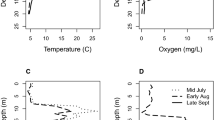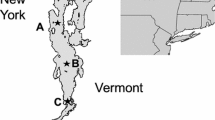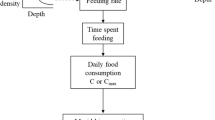Summary
Planktonic animals performing diel vertical migration (DVM) experience a tradeoff between reduced mortality and reduced reproductive output due to lower food availability in their refuge. Models of DVM as an evolutionarily stable strategy predict that, under certain conditions, strategies of both migration and non-migration can coexist. Vertical profiles of animal abundances during day and night, however, do not allow any discrimination between the behaviour of individuals or subpopulations. We used length-body protein regressions as a measure of the nutritional state ofDaphnia to distinguish possible sub-populations differing in their migration strategy. An overwhelming part of the population migrated downwards during the day. However, the few daphnids in the epilimnion during the day had significantly higher protein content than the animals in the deep water, indicating that these daphnids did not migrate randomly but remained in the surface food-rich water all day. This shows that migrating animals gain no metabolic advantage over non-migrating ones.
Similar content being viewed by others
References
Cowgill UM, Emmel HW, Hopkins DL, Takahashi IT, Parker WM (1986) Variation in chemical composition, reproductive success and body weight ofDaphnia magna in relation to diet. Int Rev Gesamten Hydrobiol 71: 79–99
Duncan A (1989) Food limitation and body size in the life of planktonic rotifers and cladocerans. Hydrobiologia 186/187: 11–28
Enright JT (1977) Diurnal vertical migration: adaptive significance and timing. Part 1. Selective advantage: a metabolic model. Limnol Oceanogr 22:856–872
Enright JT, Honegger HW (1977) Diurnal vertical migration: adaptive significance and timing. Part 2. Test of the model. Limnol Oceanogr 22:873–886
Gabriel W, Thomas B (1988a) Vertical migration of zooplankton as an evolutionarily stable strategy. Am Nat 32:199–216
Gabriel W, Thomas B (1988b) The influence of food availability, predation risk, and metabolic costs on the evolutionary stability of diel vertical migration in zooplankton. Verh Internat Verein Limnol 23: 807–811
Gliwicz MZ (1986) Food thresholds and body size in cladocerans. Nature 320:746–748
Gliwicz MZ, Pijanoska J (1988) Predation and resource depth distribution in shaping behaviour of vertical migration in zooplankton. Bull Mar Sci 43:695–709
Guisande C, Serrano L (1989) Analysis of protein, carbohydrate and lipid in rotifers. Hydrobiologia 186/187:339–346
Huntley M, Brooks ER (1982) Effects of age and food availability on diel vertical migration ofCalanus pacificus. Mar Biol 71:23–31
Johnsen GH, Jakobsen PJ (1987) The effect of food limitation on the vertical migration inDaphnia longispina. Limnol Oceanogr 32:873–880
Kremer P, Kremer JN (1988) Energetic and behavioral implications of pulsed food availability for zooplankton. Bull Mar Sci 43:797–809
Lampert W (1978) A field study on the dependence of the fecundity ofDaphnia spec. on food concentration. Oecologia 36:363–369
Lampert W (1989) The adaptive significance of diel vertical migration. Funct Ecol 3:21–27
Lampert W, Schmitt RD, Muck P (1988) Vertical migration of freshwater zooplankton: test of some hypotheses predicting a metabolic advantage. Bull Mar Sci 43:620–640
Lowry DH, Rosenbraugh NJ, Farr AL, Randall RJ (1951) Protein measurements with the Folin phenol reagent. J Biol Chem 193:256–275
Markwell MAK, Haas SM, Bieber LL, Tolbert ME (1978) A modification of the Lowry procedure to simplify protein determination in membrane and lipoprotein samples. Anal Biochem 87:206–210
Stich HB, Lampert W (1981) Predator evasion as an explanation of diurnal vertical migration by zooplankton. Nature 293:396–398
Stich HB, Lampert W (1984) Growth and reproduction of migrating and non-migratingDaphnia species under simulated food and temperature conditions of diurnal vertical migration. Oecologia 61:192–196
Wolf HG, Mort A (1986) Inter-specific hybridation underlies phenotypic variability inDaphnia populations. Oecologia 68:507–511
Author information
Authors and Affiliations
Additional information
Supported by a F.P.U. grant (Spanish Goverment)
Rights and permissions
About this article
Cite this article
Guisande, C., Duncan, A. & Lampert, W. Trade-offs inDaphnia vertical migration strategies. Oecologia 87, 357–359 (1991). https://doi.org/10.1007/BF00634591
Received:
Accepted:
Issue Date:
DOI: https://doi.org/10.1007/BF00634591




